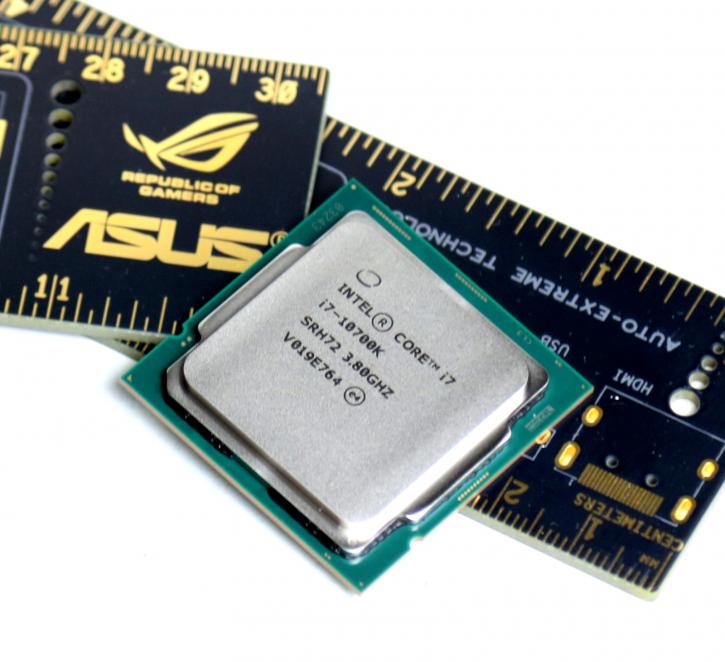An Introduction
Core i7-10700K processor review
Pack it up, pack it in, let us begin.
An overdue review is the 8-core Core i7-10700K processor from Intel. The 10th generation Intel Core desktop processors previously known as CML aka Comet Lake has been received with mixed feelings. Will the Core i7-10700K be a more attractive offer? It has been a long wait, but finally, we can share with you features, metrics, and benchmarks of the new 10th generation Intel Core desktop processors, previously known as CML, aka Comet Lake with the second-best flagship model Core i7-10700K, has eight cores and can reach a turbo frequency of up to 5.0 GHz, and 5.1 GHz with proper cooling.
What a ride the past 12 months already have been. We've seen many-core plethora releases from AMD followed by Intel Cascade Lake-X series HEDT processors. With the more recent introduction of Ryzen 3000 and the announcement of Threadripper 3000 processors the processor market and channel once again are turned upside-down (with a multitude of processors to choose from). And then everybody was waiting for that mainstream desktop processor release from Intel codenamed Comet Lake-S. Most of us expected this desktop series far earlier back in Q4 2019 already, but then COVID-19 struck the world, slowing any and all technology release down.
 |
|||||||
| i7-10700K | 8C / 16T | 3.8 GHz | 5.0 GHz | 5.1 GHz | 4.7 GHz | 125W | $374 |
A few weeks ago intel released many forms and products SKUs starting with the unlocked K series, the flagship desktop Core i9 10900K processor has a very significant 10 cores, which for intel is a pretty staggering number as their primary processor business for the desktop consumer market had been releasing and refreshing quad-core processors for many years. That slowly changed thanks to pressure from AMD, and with the more recent Coffee lake series Intel has stepped up their game, and we have seen some nice up-to 8-core parts in the series. The reality is simple, you cannot point your finger Intel for that long quad-core strategy either, as there was too little competition - hence they had no rush and have been relaxed all the way. However, they've been perhaps a bit too comfortable in that position. And with AMD a shift in that paradigm changed everything, rapidly. All of a sudden there were 6 and 8 cores processors, nice and fast. But two to three years ago another dynamic changed as Intel got (more) hit by another problem, security weaknesses. With the industry and the world in general changing, everything online is attacked in some way or form. Yes, processor vulnerabilities started to stack up for Intel, statistically significantly more than AMD. And albeit the vast majority of these vulnerabilities have been patched in software or firmware, it did have a tangible effect on performance, as well as Intel's long-lasting reputation. Current processors starting at Coffee and Comet Lake have been hardware hardened for the bigger part of Spectre and Meltdown like varieties as well as other vulnerabilities. To date, this, however, remains a sore spot and point for Intel. This entire paragraph was the perfect storm for the competition, in which they thrived.
The 10th generation into Core desktop processors running up-to 10-cores. It requires a new platform as the processor socket has changed towards 1200 pins, aka LGA1200. On April 30th of this year, 2020, Intel announced its tenth generation Core processors codenamed “Comet Lake-S”. Among the main features we have HyperThreading through the entire line of Core products, so that's from Core i3 to Core i9, up to 10 cores and 20 threads, and up to 5.3GHz for a single-core boost. As mentioned, these processors require a new motherboard, the 400 Series motherboards with an LGA 1200 socket. The new motherboards this round should last for Comet Lake-S (this gen) and Rocket Lake-S (Next-gen). Much like Generation 9 (Coffee lake-S), Comet Lake-S and the following next-gen Rocket Lake-S are based on Intel's 14nm process and you could safely say are based on the underlying microarchitecture that is Skylake, but over time refined and advanced and scaled upwards.
That means the flagship desktop processor is the Core i9-10900K with ten cores + twenty threads hyperthreading (SMT), where a single core can go up to 5.3 GHz. A Core i7-10700K with eight cores and sixteen threads would lock in at of 5.1 GHz on a single core. There are also an unlocked Core i5 processors, the best being the Core i5 10600K which we offer as a review in another article. The six cores and twelve threads will run a maximum of 4.8 GHz. You will notice the flagship processors to have a Turbo Boost frequency listing a 5.3 GHz thanks to what is called Intel Thermal Velocity Boost technology. If the processor is kept cold enough, it can run a turbo bin at that frequency.
On the next page, you can look closely at the processor prices and compare these back and forth, as Intel as roughly slashed prices in half. Most Comet Lake-S processors in the high-end segment are tagged with a 125W TDP. Priced at 374 USD, for this review, we'll be checking out that 8-core model Core i7-10700K in this specific review.

